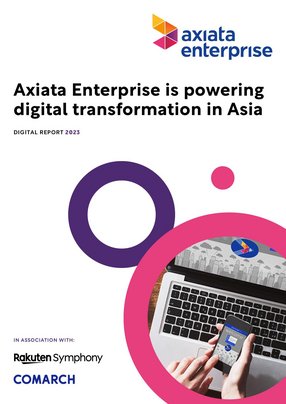Axiata Enterprise is powering digital transformation in Asia
Next-generation telecommunications company Axiata Enterprise is the B2B unit of Axiata Group. Its core mission is to bring innovation, technology and telecommunication services to support digital transformation across Asia, from its headquarters in Kuala Lumpur.
Dr. Tomek Gerszberg is the CTO for Axiata Enterprise. In his role, Gerszberg focuses on products and solutions for the enterprises across Asia and supports delivering homogenous offerings for clients by responding to customer needs with fresh innovation.
“The business is based on connectivity as the traditional telco type of business,” he says. “We grow towards managed connectivity, but also addressing the customer needs in the field of cloud, security, and system integration. Axiata Enterprise provides smart services with a strong focus on digital transformation, based on 5G.
“My career went from traditional network management to delivering innovations for enterprises,” says Gerszberg. “The company itself is highly dynamic. The evolution of the company is much faster than the evolution of the telcos we know from Europe or even from the USA.
“This is a unique opportunity for people like me to be a part of this fast transformation. Before I arrived, it was a product-oriented company. Now it's more service oriented.”
In the last two years, Axiata Enterprise has strengthened the enterprise offering and grown the business in the enterprise segments, moving from a mobile-only, consumer-focused business into the B2B sphere.
Previously, Gerszberg worked at Deutsche Telekom in Europe. Now at Axiata Enterprise, he manages different markets and adoption speeds.
“It's not necessary to categorise counties as faster or slower, because every country has its own characteristics. Indonesia, Malaysia, Sri Lanka, Bangladesh, Nepal and Cambodia are different to the markets in Europe or the USA, which are homogeneous. In Asia, the challenge is how to work out how to deliver the newest technology at the lowest possible price because that drives the adoption of the innovations.”
Gerszberg’s proudest achievement so far has been offering smart services for the industry verticals and related networks like private 5G networks.
“At Axiata Enterprise, we have built a very strong ecosystem of partners and we can deliver best-of-the-breed solutions adjusted to the customer needs and capabilities.”
Axiata Enterprise uses high-security networking solutions like Open RAN, which Gerszberg believes makes them unique in comparison to the competition in this market.
“Axiata Enterprise has probably the strongest cybersecurity practices among all telcos in the region – and we provide services related to the cloud, like cloud migrations and cloud hosting. We are delivering the security solutions, SD-WAN, SASE and managed security.”
"We also work closely with the Axiata Cyber Fusion Centre (ACFC), which is focused on real-time threat monitoring, proactive hunting, and robust protection of digital assets. With ACFC's capabilities embodying a full spectrum of protective, detective, and rapid-response capabilities, our Enterprise customers benefit from having their information and data secured and protected, so their business resilience is assured.
Axiata also manages security and smart services, which are extended beyond traditional classical definitions of Industry 4.0, going also into new verticals and new ideas like e-health or agriculture.
Axiata Enterprise’s 5G rollout in Asia
Axiata Enterprise runs a Regional Centre of Excellence for 5G.
“The goal is to provide our operating companies with the access to industry specific knowledge and advanced smart solutions from Axiata solutioning partners. This is augmented by state-of-the-art, cost-efficient private networking technology. In Axiata’s footprint the 5G public networks are not available, so private 4G/5G networking is the short cut for digital transformation.”
At Axiata Enterprise, exemplary applications of private 5G networks include:
Smart Sea Ports and Airports
5G and smart solutions help greatly increase productivity of operations and the level of security. Visual analytics, drones, remotely operated equipment and AGVs require high reliability and low latency of wireless connections. Customer made integrations in 5G require strong skills in cellular technologies, edge computing, industrial systems etc, which Axiata can deliver to its customers out of one hand.
Smart manufacturing and industrial automation
5G offers communication that is high-speed and low-latency, ideal for industrial automation and control systems. 5G is not only replacing damaged cables, but also enabling collaborative use cases for AGVs and humans. Bringing overlay sensorics and smart devices helps to add the intelligent layer to existing equipment and secures evolutionary transformation, that is more controllable than revolutionary innovation. XL Axiata projects for Indonesian mining companies are the best example of that.
Smart Cities
Public security and safety are the main areas the Smart cities are addressing nowadays. Smart solutions can also help to cope with other challenges like traffic control and efficient public transportation, or target very city specific problems, like flooding in Jakarta.
As the public 5G networks are not available yet, these businesses need to have private 5G. We need also to look at the specifics of the South Asian market where the needs of consumers and enterprises are very different, so forking 5G into consumer and enterprise one is a good strategy.
From this perspective, Axiata Enterprise has two streams which they have developed together with the group technology: one stream is designed to satisfy consumer needs on 5G and the second is to satisfy the enterprise needs.
“For the enterprise needs with regards to solutions, we have built a strong partnership with the leading, global system integrators like Capgemini and Tech Mahindra” says Gerszberg. “With those services and our capabilities, we also include strong local players to deliver the offers to the enterprises. So, our offer is a mix of global and local flavours.”
For the second part, Axiata Enterprise has the 5G networking product stack which can run on any frequency, such as licensed 4G frequencies, or unlicensed bands.
“It can run on any frequency, and this gives the possibility to deliver the networking in every place.”
This is something that Gerszberg believes makes the company so unique, especially in comparison to other operators who have been focused on delivering 5G to the public.
“We have bifurcated those processes and we focus on the enterprise needs that are very different from the consumer 5G needs,” says Gerszberg.
In the second part of Axiata Enterprise’s 5G networking, the team has signed agreements with partners such as Rakuten Symphony, Mavenir and Capgemini as network integrators. Yet there are many challenges to overcome.
For Gerszberg, the first challenge is the market perspective. “We see a very big openness to innovations,” he says. “In every market, we see that the people are curious, they want to change their business, they want to increase their efficiencies, they want to be competitive – not just locally, but on a global level.”
Gerszberg sees the willingness to innovate as one of the biggest cultural assets of Southeast Asia. At the same time, he observes a level of customer wariness. “If we consider the advanced solutions in other parts of the world, is this something that we can accommodate? Does it fit our market? My answer, as I see the businesses, is yes. The markets here are ready.”
But first, Axiata Enterprise must build trust with the enterprises, which are not in any dimension different from the leading companies in other parts of the world.
“However, this is something that will take a couple of months – through trials, proof of concepts and so on. When these companies are confident that they can work with the newest innovations, we’ll be there for them.”
Leading successful 5G digital transformation
To achieve the 5G transformation, certain technologies must be in place – primarily, 5G and the cloud.
“5G is a smart type of connectivity that enables new types of use cases, and the cloud executes the applications of those use cases,” says Gerszberg. “Here, we are talking about the edge cloud and distributed edge cloud, which are by nature the domain of the operators.”
Yet these two things mean nothing if the highest level of security is not guaranteed.
“Security has become an immersive technology for any other type of technology. Combining those three from the competence perspective makes the telco space unique and so strong.”
Axiata Enterprise has a strong partnership with Versa Networks.
“This is a natural type of partnership; as we are helping our clients to migrate the cloud, in consequence we also help to modernise the security ecosystem with products like SD-WAN and SASE.
“We have built partnerships with the cloud players, helping them to reach the markets in our geography and helping our customers to get a strong representative. I believe we fit in well in the region.”
For its 5G networking, Axiata Enterprise has partnered with Rakuten Symphony, Mavenir and Capgemini Engineering. Axiata’s partners deliver cutting edge solutions that address the needs of enterprises better than any other technology stacks. The networking is based on O-RAN technology, augmented with edge computing capabilities to run enterprise application workloads and is delivered in a fully cloud-native way, so standard off-the-shelf hardware can be deployed on customer sites. This helps Axiata to offer very competitive pricing for the newest available technology.
Digitalisation and the cloud have transformed the telecoms world.
Over the next year, the company is going to be more present in smart services, 5G networking and security.
“With the pace of the development at Axiata Enterprise, the next 12 months for the company is like 36 months in some other places,” said Gerszberg. “This is one of the priorities. We'll be much more visible in managed services on security and in all vibes of security related to on-prem security solutions, SD-WAN networking, and SASE.”
Gerszberg anticipates future trends in the telco industry, which he and his team will have to roll with. “The telco industry is undergoing the biggest transformation since digitalisation, which was in the 1990s. This is the biggest change in the last 30 years, because technology ecosystems and processes have changed so much. You need to change yourself internally with changing tools, in a changing market.”
The second trend, Gerszberg says, is consultative selling related to solutions in the vertical industries, like solutions for logistics and warehouses.
“Again, this requires knowledge about the solutions implemented worldwide,” says Gerszberg. “It requires knowledge about the business impact of the technologies in the specific verticals and it requires local capability to execute.”
He sees this as a new way of localisation, especially in the enterprise segments for the telcos. So how do you combine the global innovation trends with the local talents and local capabilities?
“I believe this is a kind of sweet spot for the telcos, because they can do that,” he says. “But the second thing is that they have the customer’s trust.”
For Gerszberg, this is still the biggest asset that any company could imagine.






